HPE6-A49 Online Practice Questions and Answers
Refer to the exhibit.
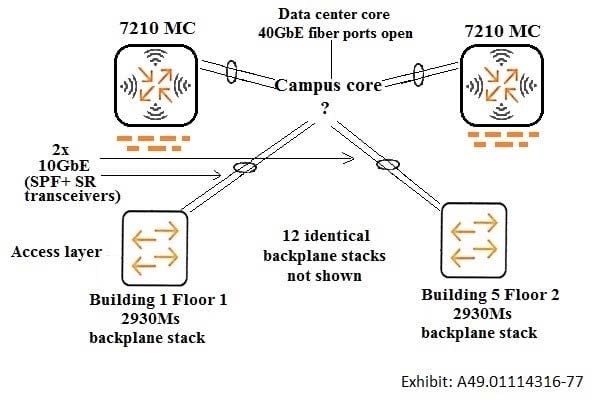
An architect has planned the wireless and wired access layers for a network upgrade. The entire solution
must support 9,000 wireless devices and 2,250 wired endpoints.
The campus core must meet these requirements:
no more than 4:1 oversubscription on the links to the data center
switch-level redundancy near instant failover if one core switch fails link aggregations between access layer and core same switch software used across the entire campus
Which exhibit shows a campus core that meets the customer needs?
A.

B.
C.


D.

Refer to the exhibit.
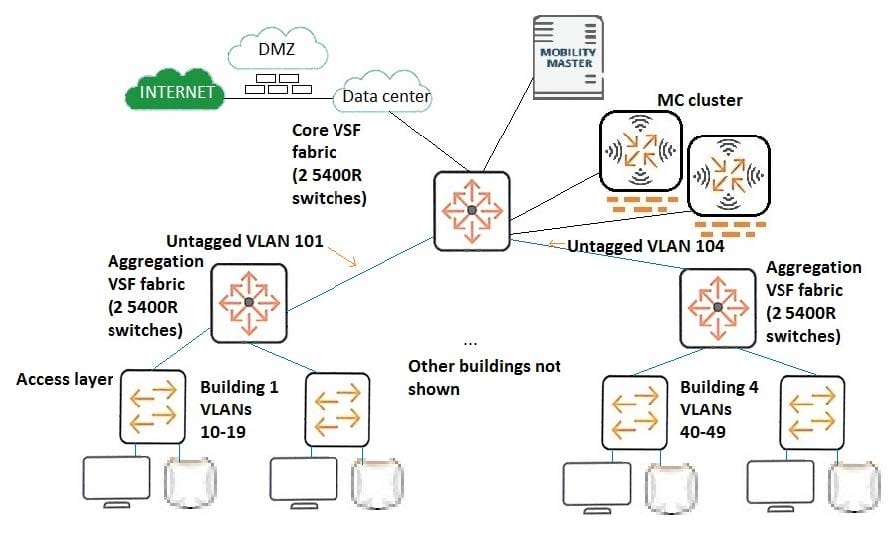
A customer has a wired infrastructure shown in the exhibit. The customer is in the process of expanding
their wireless services. They will now add a new wireless solution, with mobility controllers (MCs)
connected as shown. The new wireless solution will support a total of 450 APs and about 26,000 wireless
devices. It must provide seamless roaming across the entire campus.
After the new deployment, both wired and wireless devices experience IP connectivity issues.
Which change to the existing infrastructure should the architect recommend to support all of the customer
requirements?
A. The MCs should be moved to the aggregation layer, and more MCs added.
B. The core and aggregation switches should disable Virtual Switching Framework (VSF).
C. The core switches should be replaced with switches that have larger ARP tables.
D. The wired VLANs should be combined into a single VLAN and /16 subnet.
A customer has phones used as wireless Voice over IP (VoIP) devices. Which is one implication for the design?
A. Plan policies for the phone role on MCs to give the phones a high QoS priority.
B. Ensure a -75 GHz signal in both the 2.4GHz band and the 5GHz band across the entire site.
C. Ensure that APs connect on Smart Rate ports to support the high bandwidth demands of the phones.
D. Apply a bandwidth contract to the phone VLAN to limit broadcast and multicast traffic.
Refer to the exhibit.
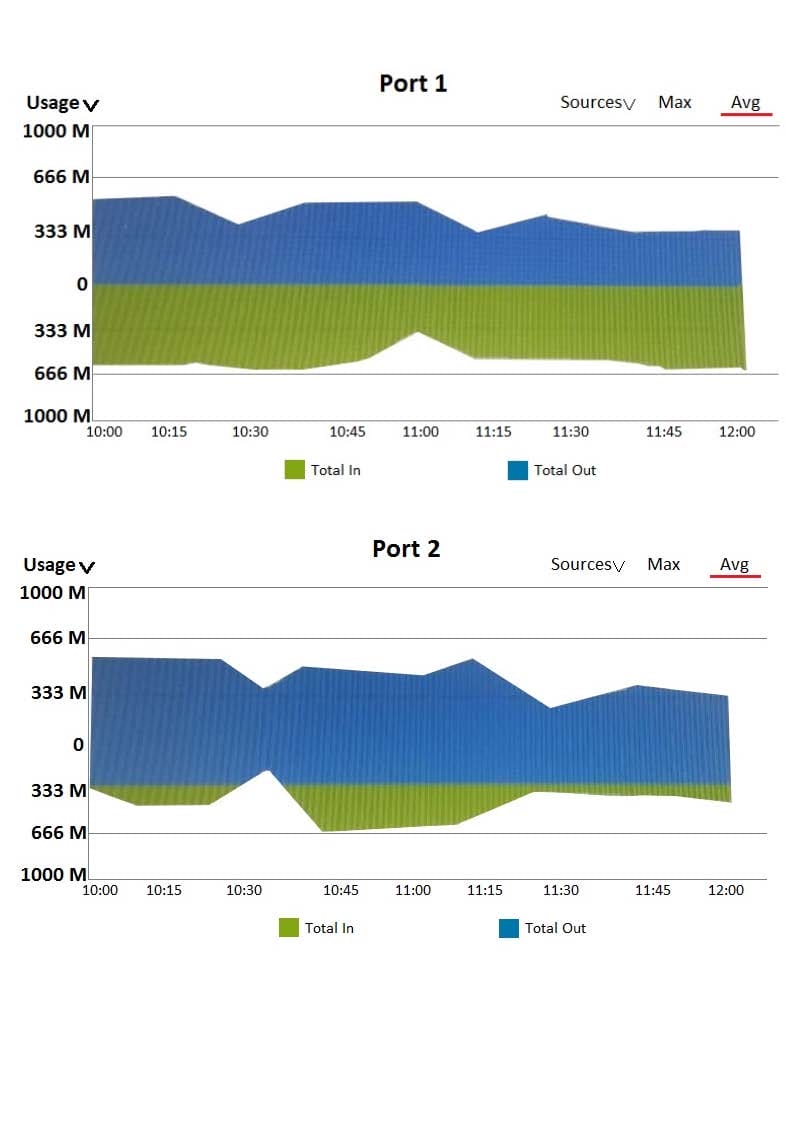
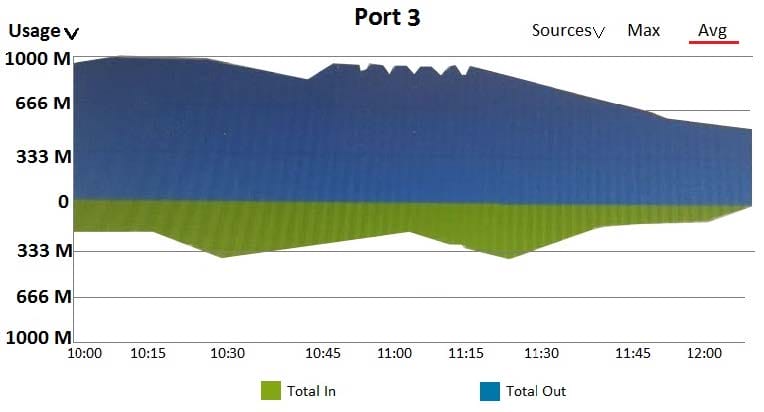
A customer needs a wired network upgrade and has complained about performance issues. The architect has collected information about traffic flow on several switch ports in different locations across the network, and the results are shown in the exhibit. Each of these ports is a 1Gbps port.
What can the architect conclude?
A. None of these ports show any periods of congestion.
B. Port 1 shows periods of congestion, other ports are not congested.
C. Port 3 shows periods of congestion, other ports are not congested.
D. All of the ports show serious congestion.
A university has a dormitory with several floors. Currently, APs are deployed in the hallways about every
50 feet (15 m). The university has several issues with the existing network:
Students complain that the wireless network is very slow, and IT staff have observed a low signal in the
student rooms.
Students want to connect some equipment, such as gaming consoles and IP TVs, on Ethernet, but the
dorm rooms just have one Ethernet port.
What could the architect plan to resolve all of these pain points?
A. Deploy an AP 335 inside each dorm room.
B. Keep the existing APs, but add more in the hallways to increase signal strength.
C. Replace the existing APs with AP 345s and add more Ethernet ports to each room.
D. Deploy an AP 303H inside each dorm room.
Refer to the exhibit.
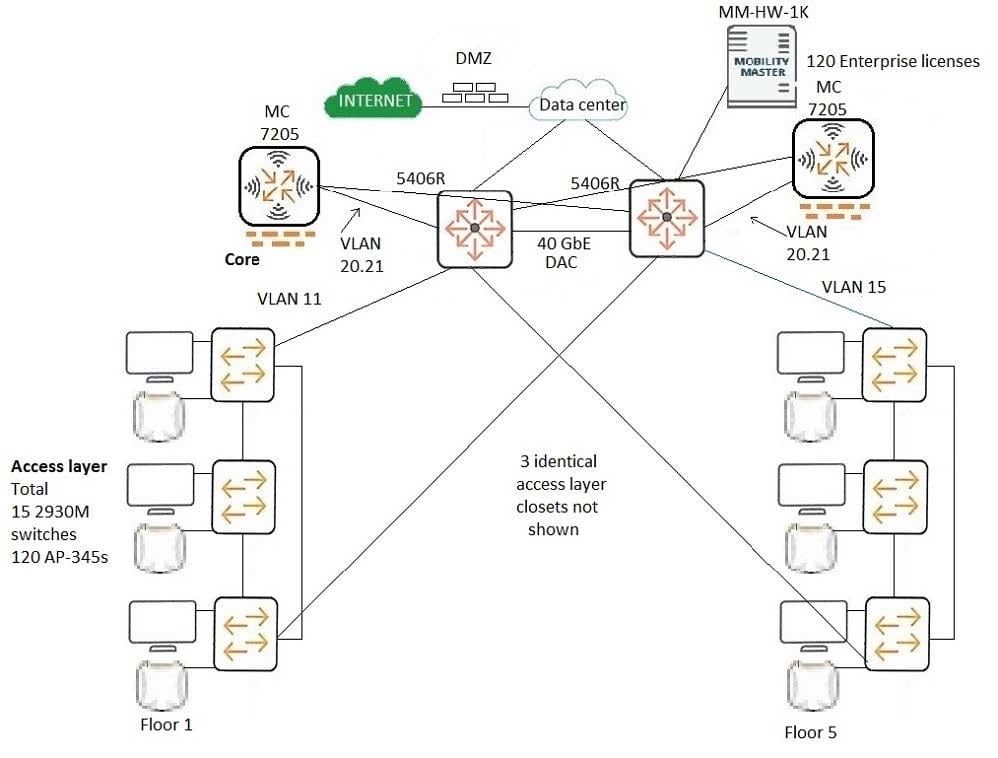
A customer has these availability requirements: loss of one controller with stateful failover and without impact on wireless client connectivity loss of one core switch without loss of connectivity for any endpoints or APs in the building loss of any one switch-to-switch or MC-to-switch link without loss of connectivity for any endpoints or APs in the building and with minimal impact on infrastructure functionality loss of any one access switch with minimal impact to wireless client connectivity
The exhibit shows the current plan for the topology.
Which change should the architect make to the plan to provide better support for the customer availability requirements?
A. Use two 40GbE DACs for the VSF link between the core switches.
B. Add VLANs 11 and 15 to the MC connections to ensure both MCs can manage any of the APs.
C. Add 120 additional AP licenses, so that each MC can support all the APs even if the other MC fails.
D. Change the 40GbE DAC on the 5406R switch to a stacking cable with stacking module.
A network architect plans to propose a virtual Mobility Master (VMM) for a new solution. The solution will support up to 4,800 wireless client devices and include: two Virtual Mobility Controllers (VMCs) in a cluster 180 APs
Which licenses should the architect propose?
A. 1 MM-VA-500; 2 MC-VA-250; 540 Enterprise licenses
B. 1 MM-VA-500; 1 MC-VA-250; 180 Enterprise licenses
C. 1 MM-VA-1K; 2 MC-VA-250; one Enterprise license
D. 1 MM-VA-1K; 1 MC-VA-250; 180 Enterprise licenses
A customer has an existing Aruba wireless solution to provide wireless access for employees. The solution includes APs, mobility controllers (MCs) at the network core, and a Mobility Master (MM). A customer would like to set up a separately managed guest network and have the traffic go directly to the DMZ.
What should the architect suggest as the simplest solution that meets the requirements?
A. Add APs in a dedicated AP group to support only the guest network SSID.
B. Have a dedicated mobility controller in the DMZ managed by the same MM.
C. Double the number of APs and controllers
D. Use MultiZone, and put a mobility controller in the DMZ.

A stadium wants to deploy location-based services, including blue-dot wayfinding over a 200,000 square
foot (18,580 sq. m) area. The customer also wants to enable targeted notifications when guests walk past
particular areas. The customer has selected a 1 year subscription.
The exhibit shows the BOM that the architect created in Iris.
Which correction should the architect make?
A. Add another campaign subscription
B. Add two Maps subscriptions
C. Remove one Blue Dot Nav subscription
D. Change the campaign subscription to a Maps subscription
A customer has a campus that has expanded to several buildings. The buildings are between 100 and 200
feet (30 m and 61 m) apart and connected with SM fiber. The customer currently has instant APs (IAPs)
clusters on several floors of several buildings. The customer has consolidated central resources in a small
data center in one of the buildings.
The customer would like a more centralized architecture in which all wireless traffic is tunneled to the data
center and IAPs are managed centrally.
What should the architect recommend?
A. Deploy Aruba MCs in a central location, and convert IAPs to CAPs.
B. Purchase a license for a Virtual Mobility Master (VMM).
C. Deploy Aruba AirWave in a central location.
D. Purchase a subscription for Aruba Central device management.
Case study
A customer needs a wireless network upgrade for 802.11ac and possibly an upgrade to the wired network.
The customer requires dual-radio 802.11ac APs, each radio of which can support 4x4 MIMO at full feature
set.
The customer has given architects this information about their wireless devices:
2700 IoT devices which will have only wireless connections; they support WPA2 with 802.1X
300 on each floor in 3 buildings with 3 floors each
5,400 users, who use devices such as laptops and smartphones
600 users on each floor in 3 buildings with 3 floors each
24 security cameras which will have only wireless connections; they support WPA2 with 802.1X and have
a local power source
4 on floor 1 of each of the 3 buildings
2 on the other 6 floors
The architect also has collected information about the existing wired network.
The existing access layer switches support these features:
10/100/1000 edge ports
PoE (802.3af)
1GbE fiber uplinks
The existing aggregation switches support these features:
1/10GbE fiber ports
ARP tables up to 62,000
The customer has provided this figure that shows the existing cabling between floors and between
buildings:

Each floor is about 100 feet (30 m) by 140 feet (43 m) with a 10 foot (3 m) ceiling. Interior walls are drywall. The layout for each floor is similar to that shown below. CAT5e cable is extended to all areas.

What is one piece of additional information architects should obtain from the customer before they design the wireless solution?
A. whether the users sometimes connect their laptops with Ethernet
B. whether the IoT devices support MAC-Auth
C. the number of concurrently used wireless devices per user
D. the power requirements for the security cameras
A retailer has many small outlets. Each outlet has: a local Internet connection, but no local services. The outlets have no local IT staff. All traffic must go through the main office. Devices at the site are primarily POS systems.
The retailer currently has a complex VPN solution, but would like to: Shift entirely to wireless devices with a new 802.11ac network Simplify network setup for existing and new outlets
The architect has examined the sites and determined that each will require about 1 to 3 APs. The customer wants the most cost-effective solution that meets the requirements.
Which solution should the architect recommend for each remote site?
A. Instant APs (IAPs) with CPSec control channels to Aruba Central
B. Campus APs (CAPs) with CPSec control channels to a main office MC
C. Remote APs (RAPs) with IPsec tunnels to a main office MC
D. Campus APs (CAPs) with a local MC that has an SD-WAN license
A customer requires new MCs for a large multi-site network with about 600 AP-345s and 30,000 wireless clients. The customer requires redundancy for the MCs with each MC being able to handle the full load in a failover situation. The network should be able to sustain the loss of a controller with stateful failover within seconds. It should be able to undergo software upgrades without downtime. The architect has recommended two 7240XM MCs. The customer points out that 7220 MCs can support enough APs and wonders why the architect recommended the 7240XMs.
What should the architect explain?
A. The 7240XMs MCs are required to support the large number of wireless clients in this network.
B. The 7240XMs MCs support 40GbE ports, which are desirable for future proofing.
C. The 7240XMs MCs can support full CPSec tunnels with this number of APs, while the 7220 MCs cannot.
D. The 7240XMs MCs have more advanced clustering and availability capabilities than the 7220s MCs.
The airport needs to support several different SSIDs, including:
four for individual airlines
one for the airport as a whole
one for airport security
The airport security traffic must terminate on different mobility controllers (MCs) from the rest of the airport
traffic and be managed entirely separately. Airlines also want to terminate traffic at their MCs.
The airport MCs and airport security MCs require redundancy while airlines do not.
Which plan for MCs and Mobility Master (MM) meets the needs of this scenario?
A. one MCs for the airport, one MC for airport security, and one MC for each of the four airlines with its own SSID, all controlled by the same MM
B. one MCs for the airport, a cluster of MCs for airport security controlled by a pair of MMs, and one MC for each of the four airlines
C. a cluster of MCs for the airport, a cluster of MCs for airport security, and one MC for each of four airlines, all controlled by the same MM pair
D. a cluster of MCs for the airport controlled by an MM pair, a cluster of MCs for airport security controlled by a different MM pair, and one standalone MC for each of the four airlines.
A hospital needs a better way to track its inventory, including wireless medical devices that are moved
around the site a lot.
Which solution meets these needs?
A. Aruba asset tags and beacons
B. Aruba asset tags, APs, and Meridian
C. Aruba beacons, APs, and AirWave
D. Aruba beacons and Meridian
